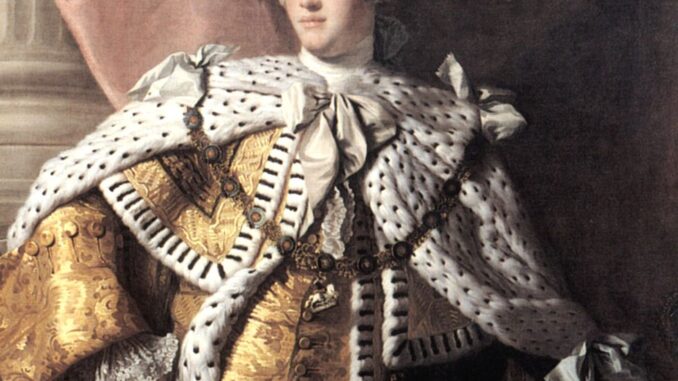
The Bridgerton prequel about Queen Charlotte dives into King George’s so-called “madness” during his reign.
In Queen Charlotte: A Bridgerton Story, the mental health struggles that a young King George (played by Corey Mylchreest) faces are a key part of the plot. The complete of episode four, “Holding the King,” focuses on the events of the first three episodes from George’s perspective, and the inability of royal doctors to treat him. Although the show is fictional, the real King George III did likely suffer from mental illness.
George ascended to the throne at age 22, and was King of Great Britain until his death in 1820 at age 81. In the last decade of his reign, he was considered mentally unfit to rule, and his eldest son, Prince George Augustus Frederick was Prince Regent—marking the beginning of the “Regency” era.
What was wrong with King George III? What caused his mental illness, or his “madness” as is was called? Even the royal family’s official website writes, “George III is widely remembered for two things: losing the American colonies and going mad. This is far from the whole truth.”
The real answers may be lost to history, but there are a few theories.
In the 1960s, psychiatrists Ida Macalpine and Richard Hunter argued in the British Medical Journal that George had acute porphyrias, a metabolic disorder that impacted the nervous system. Recent research, like a paper from Timothy Peters in 2011 in Clinical Medicine, says that Macalpine and Hunter were “highly selective in their reporting and interpretation of his signs and symptoms and that the diagnosis of the acute porphyria cannot be sustained,” argued them ” sought to remove ‘the taint of madness’ from the House of Windsor.”
Instead, Peters proposes that King George III actually suffers from recurrent mania, possibly bipolar disorder. He notes George was diagnosed at the time with was then called “manic depressive psychosis.”

Other researchers have agreed with this diagnosis; Peter Garrard and Vassiliki Rentoumi, analyzing the letters written by George III during “mentally healthy and apparently mentally ill periods,” backing up the bipolar disorder diagnosis, writing, “in the modern classification of mental illness acute mania now appears to be the diagnosis that fits best with the available behavioral data.” Garrad told the BBC, “The porphyria theory is completely dead in the water. This was a psychiatric illness.”
The royal family’s website notes, “We may never know exactly what was wrong with George III, it may have been hypomania, but researchers studying his papers have found that breakdowns often came amid turmoil at home, including the premature death of his youngest daughter Princess Amelia from tuberculosis.” Hypomania is a type of mania, often part of bipolar disorder.
In the last decade of his life, in addition to the acute mania and blindness from bilateral cataracts, George also possibly suffered from dementia.
As Queen Charlotte depicts, the treatments George was put through were painful and inhumane—and included wearing a straitjacket, bloodletting, blistering, and more. Dr. Francis Willis, a doctor who treated George, wrote in his diary in March 1801, “His Majesty’s feet were put into hot water and vinegar for half an hour. Soon after this His Majesty put on such an appearance of being exhausted, that his life was despaired of — his pulse too had rapidly increased.”
Whatever befell King George III, it is clear that the doctors at the time did not have the tools to treat him. As novelist William Makepeace Thackeray wrote of George III in The Four Georges, “All the world knows the story of his malady: all history presents no sadder figure than that of the old man, blind and deprived of reason, wandering through the rooms of his palace, addressing imaginary parliaments, reviewing fancied troops, holding ghostly courts.”
George would die at Windsor Castle in 1820.
